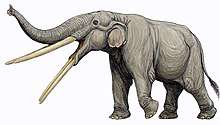Stegotetrabelodon
Stegotetrabelodon is an extinct genus of primitive elephant with gomphothere-like anatomical features from the Late Miocene to Early Pliocene of Africa and Eurasia. The type species is S. syrticus of late Miocene Africa, which reached roughly 4 m (13.1 ft) in shoulder height and 11–12 tonnes (12.1–13.2 short tons) in weight.[1] The other unequivocally recognized species is S. orbus, also of late Miocene Africa. Other species outside of Africa are questionably placed in this genus, including teeth from Late Miocene Hungary and Iran originally described as being of the Mastodon subgenus Bunolophodon, Chinese specimens originally described as being also of Mastodon, as well as of Tetralophodon and Stegodon, and a species from the late Miocene-aged Dokh Pathan Formation in Pakistan, S. maluvalensis.[2]
| Stegotetrabelodon | |
|---|---|
| Stegotetrabelodon syrticus jaw | |
| Scientific classification | |
| Kingdom: | Animalia |
| Phylum: | Chordata |
| Class: | Mammalia |
| Order: | Proboscidea |
| Family: | Elephantidae |
| Genus: | †Stegotetrabelodon |
| Type species | |
| † Stegotetrabelodon syrticus Petrocchi, 1941 | |
| Species | |
| |

Arabian Peninsula
In December 2006, a small contingent of Emirates Natural History Group members found several sets of proboscidean footprints thought to belong to Stegotetrabelodon preserved in a large calcareous exposure between the sand dunes of "Mleisa 1"[3] in the Western Region[4] of the Emirate of Abu Dhabi, the United Arab Emirates. The longest of these tracks extend for 290 m (950 ft) and 170 m (560 ft).[5]
References
- Larramendi, A. (2016). "Shoulder height, body mass and shape of proboscideans" (PDF). Acta Palaeontologica Polonica. 61. doi:10.4202/app.00136.2014.
- Whybrow, P.J. (1999). Faqārīyāt Al-uḥfūrīyah Fī Al-Jazīrah Al-ʻArabīyah. Yale University Press. p. 523. ISBN 0-300-07183-3.
- Mauguit, Quentin (2012-02-23). "Des empreintes de 7 millions d'années racontent les éléphants d'autrefois". Futura (in French). Retrieved 2018-10-11.
- "Des empreintes de 7 millions d'années racontent les éléphants d'autrefois". Futura (in French). Retrieved 2018-10-11.
- Hill, Andrew; Bibi, Faysal; Beech, Mark; al-Tikriti, Walid Yasin (January 2012). "Before archaeology: Life and environments in the Miocene of Abu Dhabi". ResearchGate. p. 27.
| Wikimedia Commons has media related to Stegotetrabelodon. |
| Wikispecies has information related to Stegotetrabelodon |
- Lister, Adrian; Bahn, Paul G. (1994). Mammoths: Giants of the Ice Age. New York: Macmillan. ISBN 0-02-572985-3.
- McKenna, Malcolm C.; Bell, Susan K. (1997). Classification of Mammals. New York: Columbia University Press. ISBN 0-231-11012-X.